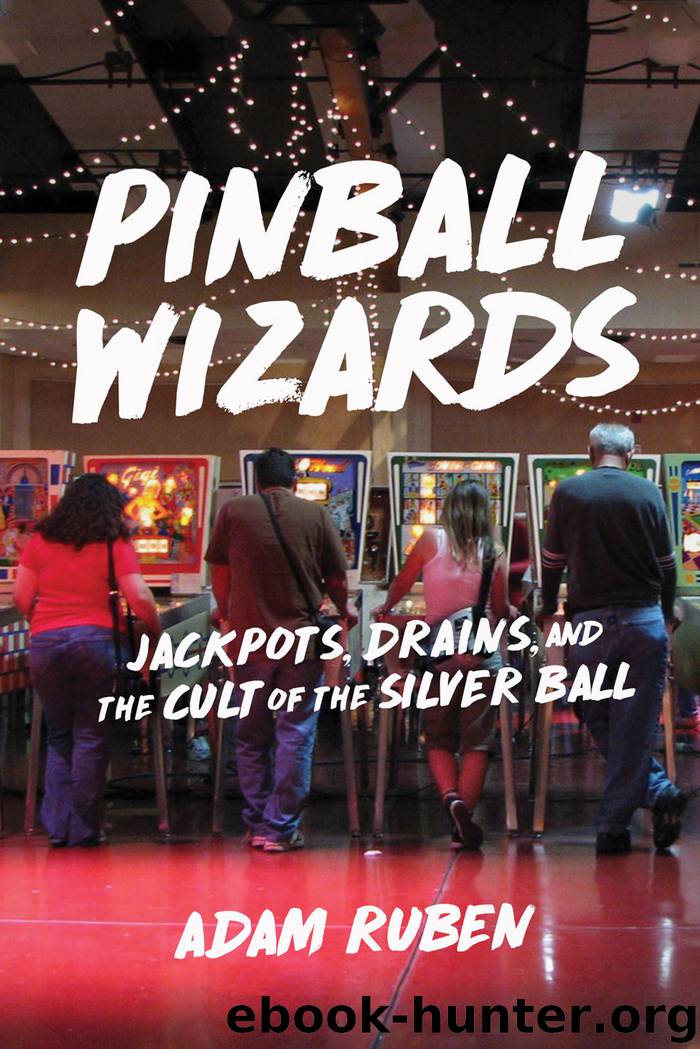Pinball Wizards by Adam Ruben

Author:Adam Ruben
Language: eng
Format: epub
Publisher: Chicago Review Press
Published: 2017-02-15T00:00:00+00:00
8
The Day Pinball Died
* * *
PINBALL HAD ONE LAST SHOT. The industry had been on life support for much of the late ’90s, selling about tenfold fewer machines in 1999 than in 1992. If pinball was to have a future, manufacturers would need to do something drastic.
“Management said we need to make it profitable,” said designer George Gomez in a now-famous seminar at the annual public Pinball Expo, later transcribed verbatim in Pinball Player, the magazine of the Pinball Owners Association. It was Saturday, October 23, 1999, and Gomez had arrived to triumphantly boast how he and his dedicated coworkers had just saved the industry with their new invention. WMS, Gomez’s employer, told him and his fellow designers that “the world has changed. Nobody wants what you guys are doing. You’re boring everybody. Invent something new.”
To Gomez’s colleagues, it must have seemed like a “What more do you want from me?” moment. All they’d done for the past several years was innovate; each new game was cleverer than the last, and still pinball was going down the toilet.
So Gomez, with the help of Pat Lawlor, Lyman Sheats, and dozens of others, devised something innovative. Something no one had created before, something fantastic and fun, something that, according to game designer Duncan Brown, “actually turned a profit for the first time in a long time.”
Perhaps you’ve seen Pinball 2000, the mashup of pinball and video games that WMS produced as its Hail Mary pass. It was essentially a regular pinball machine, slightly smaller, but with a holographic video display somehow magically projected perpendicular to the playfield. Playing Pinball 2000, a.k.a. PB2K, was like playing real, physical pinball from inside a video game. The first machine using Pinball 2000 technology was called Revenge from Mars (1999), and among other neat holographic tricks, for example, the game could project a little green Martian at the bottom of a ramp—and sending the pinball up that ramp “squashed” the Martian, which vanished after a brief animated death.
No two ways about it, PB2K was awesome. For a while, it looked like the geniuses at WMS had done it again, inventing not just a new gadget but rather a whole new revolutionary platform for pinball machines, devised from the ground up, amazing, beloved, lucrative.
But not lucrative enough. And when Gomez gave his seminar at Pinball Expo, he must have felt the winds of change starting to blow. “My spider sense has been on fire this last month,” Gomez cautiously concluded his talk. “Pinball will survive . . . [but] I fear that our company may have lost the ability to make it make economic sense. If that’s the case, being as it’s a business, they might choose not to be in the pinball business.”
Unfortunately, Gomez’s spider sense was excellent. On the very next working day after Gomez’s seminar, Monday, October 25, 1999, WMS—the only publicly traded pinball company, which at the time had a 70–75 percent market share in the pinball industry (the rest belonged to Stern Pinball, which had recently bought Sega)—stopped producing pinball machines forever.
Download
This site does not store any files on its server. We only index and link to content provided by other sites. Please contact the content providers to delete copyright contents if any and email us, we'll remove relevant links or contents immediately.
| Coloring Books for Grown-Ups | Humor |
| Movies | Performing Arts |
| Pop Culture | Puzzles & Games |
| Radio | Sheet Music & Scores |
| Television | Trivia & Fun Facts |
The Infinite Retina by Robert Scoble Irena Cronin(6152)
Harry Potter and the Cursed Child: The Journey by Harry Potter Theatrical Productions(4438)
The Sports Rules Book by Human Kinetics(4288)
Molly's Game: From Hollywood's Elite to Wall Street's Billionaire Boys Club, My High-Stakes Adventure in the World of Underground Poker by Molly Bloom(3485)
A Knight of the Seven Kingdoms by George R R Martin(3186)
Quidditch Through the Ages by J.K. Rowling(3061)
How To by Randall Munroe(3030)
Flowers For Algernon by Daniel Keyes(3016)
Quidditch Through the Ages by J K Rowling & Kennilworthy Whisp(2927)
Quidditch Through the Ages by Kennilworthy Whisp by J.K. Rowling(2812)
Stacked Decks by The Rotenberg Collection(2809)
Quidditch through the Ages by J. K. Rowling(2768)
Quidditch Through The Ages by J. K. Rowling(2728)
776 Stupidest Things Ever Said by Ross Petras(2692)
Ready Player One: A Novel by Ernest Cline(2646)
What If?: Serious Scientific Answers to Absurd Hypothetical Questions by Randall Munroe(2637)
Beautiful Oblivion by Jamie McGuire(2567)
The Book of Questions: Revised and Updated by Gregory Stock Ph.d(2515)
Champions of Illusion by Susana Martinez-Conde & Stephen Macknik(2414)
